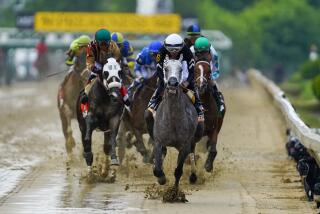First Step on a Long Road
- Share via
KENNETT SQUARE, Pa. — A team of veterinary surgeons trying to save the life of Kentucky Derby winner Barbaro operated on the colt’s shattered right hind leg for more than four hours Sunday, and after a nearly eight-hour ordeal the horse was standing unassisted in a special stall Sunday night.
Yet amid exuberance that the horse came through a very difficult surgery a day after stunned onlookers saw him break down in the opening seconds of the Preakness Stakes, doctors warned that Barbaro’s survival is far from certain.
“This is to be brutally honest: He’s still a coin toss, even after everything went well,” said Dr. Dean Richardson, who oversaw a team of four surgeons during an exhausting procedure in which a 16-hole metal plate and 23 screws were inserted in the colt’s leg.
“The most important thing to emphasize is this is just the absolute first step,” said Richardson, chief of surgery at the University of Pennsylvania’s George D. Widener Hospital at New Bolton Center, a nationally renowned animal hospital not far from the homes of trainer Michael Matz and Barbaro’s owners, Gretchen and Roy Jackson.
Among the special facilities at New Bolton Center that enabled the colt to come through surgery well is a swimming pool in which horses are suspended in warm water by a waterproof harness and inflatable raft as they wake from anesthesia.
The floating sling protects the animal from further injuring itself during the “flight” response that occurs when a horse awakes in unfamiliar surroundings, Richardson said.
Barbaro, whose leg is in a cast, was lifted out of the pool and taken to an intensive care stall where he will receive 24-hour care.
“All he has to do is push a button and the nurse will be there,” Richardson joked, adding that the dark-bay colt “practically jogged” to his stall and was eating hay at about 8:45 p.m. EDT after being put under anesthesia for the procedure at 1 p.m.
Matz, who had rushed onto the track at Pimlico Race Course Saturday after his horse was pulled up by jockey Edgar Prado only moments into the Preakness, smiled but looked haggard at a news conference with Richardson.
“From the last time I saw him to now is a big relief,” Matz said. “I feel more relieved after seeing him walk to his stall than when we loaded him into the ambulance to come up here, that’s for darn sure.”
Determining whether the horse will ultimately survive and go on to a stud career could take months, Richardson said, as doctors wait to see if surgery to repair three fractures and fuse his ankle will succeed. They also must wait to see whether he will avoid not only infection but the many risks particular to horses, who must convalesce largely on their feet.
Two good signs for Barbaro were the indication of a good blood supply to his injured leg, and his ability to get up and down on his own, said Richardson, who noted before the surgery the injury was “as bad as it can be.”
Barbaro had three fractures -- a broken cannon bone and a broken sesamoid bone above the ankle, and below it, a broken long pastern bone that Richardson said was in 20 pieces. The colt also has a dislocated fetlock, or ankle joint.
“Most of the horses who suffer this severe an injury are typically put down on the racetrack,” Richardson said.
But this was a special horse.
The undefeated colt inspired hopes of the first Triple Crown since Affirmed in 1978 after a 6 1/2 -length Derby victory, the largest margin since 1946.
Saturday night, people gathered on Interstate 95 overpasses as the equine ambulance made the 70-mile trip from Baltimore, Matz said.
During the long wait to see how Barbaro would come through surgery Sunday, flowers arrived at the hospital, some of them carried by children. Two apples and a handful of carrots were accompanied by a handwritten note.
Although his racing career is over, Barbaro has more than sentimental value.
If he were sold as a stallion to stand at stud, he might fetch $20 million. Some stallions command fees of $100,000 for each mating that produces a live foal.
Barbaro’s injury was a bizarre one, and because it came after a false start when he broke through the gate early, questions were being asked about whether the horse should have been allowed to return to the gate for the race.
Richardson and Matz said after looking at replays they believed the colt was not injured on the false start. Barbaro was briefly examined, and reloaded.
“I think the vets looked him over. I don’t think there was a problem then,” Matz said.
Prado said he thought Barbaro simply took “a bad step” shortly after the official start and that he heard a pop after about 100 yards.
Veteran trainer Bob Baffert said by telephone he did not believe the injury was because of the false start and noted the gates were secured by magnets so they would give way, preventing a horse from being injured.
“I know everybody wants a defining moment why it happened,” Baffert said. “It was just a bad step.”
It is part of racing, and so early Sunday morning, Matz was at his barn near Elkton, Md., tending to his other horses.
Two weeks ago, he celebrated a Kentucky Derby victory. He spent Saturday and Sunday wondering if Barbaro would be put down.
“It can be a very cruel sport sometimes,” he said.
More to Read
Go beyond the scoreboard
Get the latest on L.A.'s teams in the daily Sports Report newsletter.
You may occasionally receive promotional content from the Los Angeles Times.










